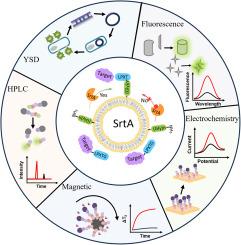Advances in the detection of Sortase A activity in Staphylococcus aureus
IF 4.9
Q1 CHEMISTRY, ANALYTICAL
引用次数: 0
Abstract
Staphylococcus aureus (S. aureus) is one of the most common and important pathogenic bacteria and is the leading cause of hospital-acquired infections. Sortase A (SrtA), a cell surface-anchored transpeptidase in S. aureus, plays a critical role in the attachment of virulence-associated proteins to the cell wall. Given that SrtA is not directly involved in bacterial survival but mainly regulates pathogenicity, it has emerged as an attractive therapeutic target for developing anti-virulence strategies. Quantitative analysis of SrtA activity provides valuable insights into S. aureus colonization levels and virulence potential. Moreover, the detection method for SrtA facilitates the screening of inhibitors, and contributes to not only fundamental biological research but also pharmaceutical development and medical diagnostics. In this review, we discuss recent advances and modern techniques in novel methods for identifying SrtA activity, such as porous silicon resonant microcavities (pSiRM), magnetic nanoparticles, fluorescent proteins, and fluorescence resonance energy transfer (FRET)-based technologies. Additionally, we provide an objective evaluation of current biosensing technologies including high-performance liquid chromatography (HPLC), fluorescent, and electrochemical biosensors, with particular emphasis on their respective advantages and limitations in SrtA activity detection and inhibitor screening. This review aims to provide scientific evidence and potential strategies for developing new therapies against drug-resistant S. aureus while highlighting promising directions for next-generation anti-infective strategies.

金黄色葡萄球菌中分类酶A活性检测的研究进展
金黄色葡萄球菌(金黄色葡萄球菌)是最常见和重要的致病菌之一,是医院获得性感染的主要原因。分类酶A (SrtA)是金黄色葡萄球菌细胞表面锚定的转肽酶,在毒力相关蛋白附着在细胞壁上起关键作用。由于SrtA不直接参与细菌存活,而主要调控致病性,因此它已成为开发抗毒策略的一个有吸引力的治疗靶点。SrtA活性的定量分析为金黄色葡萄球菌定植水平和毒力潜力提供了有价值的见解。此外,SrtA的检测方法有助于抑制剂的筛选,不仅有助于基础生物学研究,还有助于药物开发和医学诊断。在这篇综述中,我们讨论了鉴定SrtA活性的新方法的最新进展和现代技术,如多孔硅谐振微腔(pSiRM)、磁性纳米颗粒、荧光蛋白和基于荧光共振能量转移(FRET)的技术。此外,我们还客观评价了当前的生物传感技术,包括高效液相色谱(HPLC)、荧光和电化学生物传感器,特别强调了它们在SrtA活性检测和抑制剂筛选方面的各自优势和局限性。本文旨在为开发耐药金黄色葡萄球菌的新疗法提供科学依据和潜在策略,同时强调下一代抗感染策略的发展方向。
本文章由计算机程序翻译,如有差异,请以英文原文为准。
求助全文
约1分钟内获得全文
求助全文
来源期刊

Sensing and Bio-Sensing Research
Engineering-Electrical and Electronic Engineering
CiteScore
10.70
自引率
3.80%
发文量
68
审稿时长
87 days
期刊介绍:
Sensing and Bio-Sensing Research is an open access journal dedicated to the research, design, development, and application of bio-sensing and sensing technologies. The editors will accept research papers, reviews, field trials, and validation studies that are of significant relevance. These submissions should describe new concepts, enhance understanding of the field, or offer insights into the practical application, manufacturing, and commercialization of bio-sensing and sensing technologies.
The journal covers a wide range of topics, including sensing principles and mechanisms, new materials development for transducers and recognition components, fabrication technology, and various types of sensors such as optical, electrochemical, mass-sensitive, gas, biosensors, and more. It also includes environmental, process control, and biomedical applications, signal processing, chemometrics, optoelectronic, mechanical, thermal, and magnetic sensors, as well as interface electronics. Additionally, it covers sensor systems and applications, µTAS (Micro Total Analysis Systems), development of solid-state devices for transducing physical signals, and analytical devices incorporating biological materials.
 求助内容:
求助内容: 应助结果提醒方式:
应助结果提醒方式:


